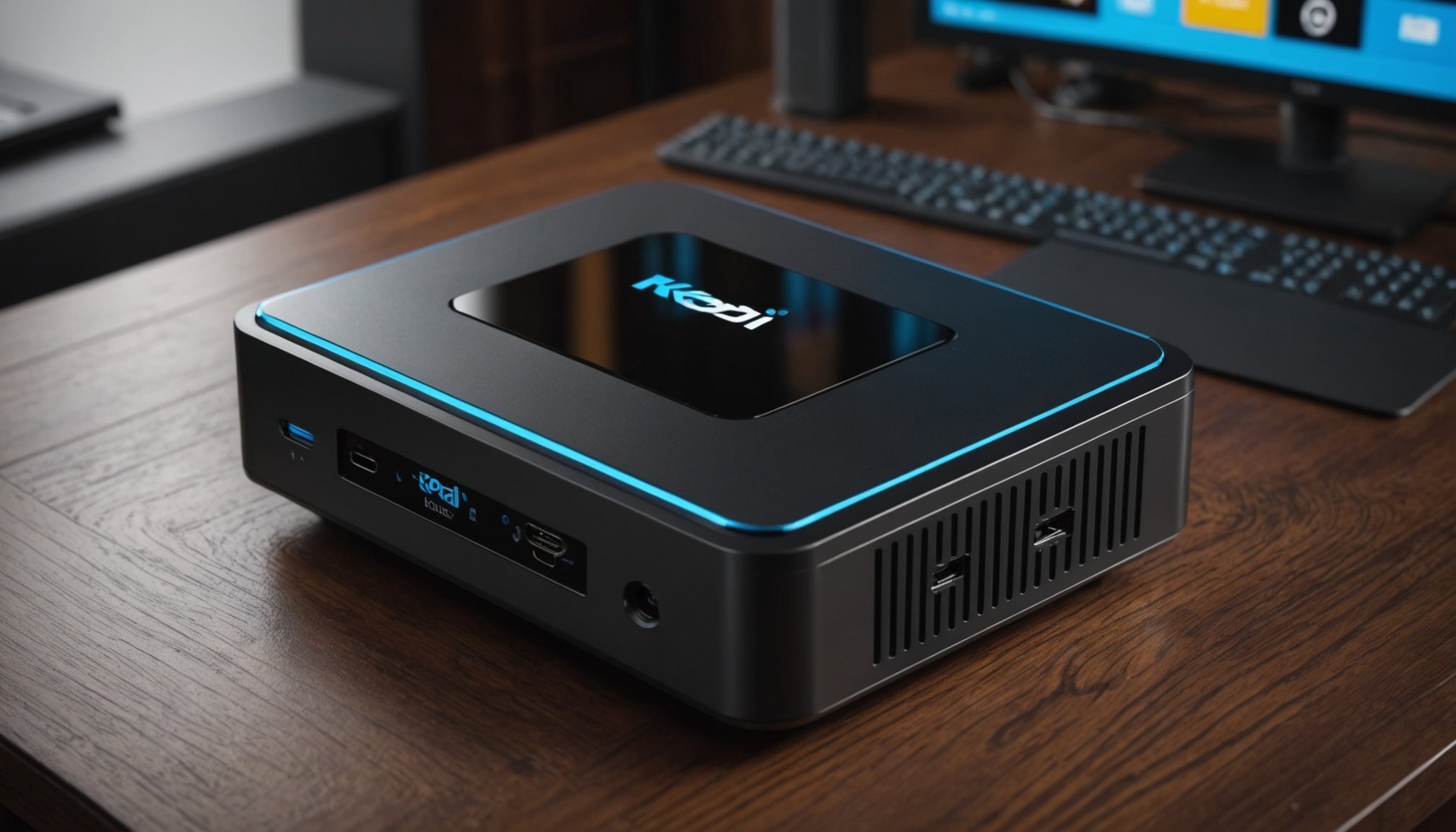Ultimate Guide to Perfectly Optimizing Your Intel NUC for Seamless 4K Streaming with Kodi
Why Choose an Intel NUC for 4K Streaming?
When it comes to building a home theater PC (HTPC) for seamless 4K streaming, an Intel NUC (Next Unit of Computing) is an excellent choice. These mini PCs are compact, powerful, and highly customizable, making them ideal for running media centers like Kodi.
“Intel NUCs are perfect for HTPC setups because they offer a great balance of performance and size,” says a user on the Whirlpool forums. “You can easily place them behind your TV or in a small cabinet, and they are powerful enough to handle 4K video playback.”
Topic to read : Ultimate Guide to Building a High-Performance 3D Rendering Workstation with AMD Threadripper 3960X
Hardware Requirements for 4K Streaming
To ensure your Intel NUC can handle 4K streaming, you need to pay attention to several key hardware components:
Processor
A recent-generation processor is crucial. For example, the 12th Gen Intel Alder Lake-N95 processor, found in some of the latest Intel NUC models, offers up to 3.4 GHz clock speed and 4 cores/4 threads, which is more than sufficient for 4K video playback[1].
Also to see : Top Strategies for Creating a Safe and Streamlined Home Automation System with Your Google Nest Hub
Graphics Card
Integrated graphics are often sufficient for 4K streaming, but having a dedicated graphics card can enhance performance. However, for most users, the integrated Intel Iris or UHD graphics will be more than adequate.
RAM and Storage
Ensure your NUC has at least 8GB of RAM, but 16GB or more is recommended for smoother performance. For storage, an SSD (Solid State Drive) is a must. It significantly improves loading times and overall system responsiveness.
Connectivity
Make sure your NUC has the necessary ports for your setup, including HDMI 2.0 for 4K output, USB ports for peripherals, and an Ethernet port for a stable internet connection.
Setting Up Your Intel NUC
Installing the Operating System
You can run various operating systems on your Intel NUC, but for 4K streaming with Kodi, Windows 10 or a Linux distribution like Ubuntu or LibreELEC are popular choices.
“LibreELEC is a great option if you want a lightweight OS specifically designed for running Kodi,” advises a user on the Kodi forums. “It’s easy to install and configure, and it provides excellent performance for media playback.”
Installing Kodi
Once your OS is installed, download and install Kodi from the official website. Kodi is an open-source media player that supports a wide range of video formats and streaming services.
Optimizing Kodi for 4K Streaming
Video Settings
To optimize Kodi for 4K streaming, you need to tweak several video settings:
-
Adjust Refresh Rate: Ensure that the refresh rate of your display is matched with the video content. In Kodi, go to
Settings>Videosand selectAdjust refresh ratetoOn start/stopto synchronize the display’s refresh rate with the video’s frame rate[5]. -
Sync Video with Display: If adjusting the refresh rate doesn’t solve any issues, enable
Sync video with displayto synchronize both video and audio with the display’s refresh rate. However, note that this may disable audio passthrough[5]. -
HQ Scaler: Enable the
HQ Scalerfor upscaling lower resolution videos to higher resolutions. Set the scaler to activate for scaling greater than a certain percentage (e.g., 20%) to avoid pixelation and improve video quality[5]. -
Hardware Acceleration: Allow hardware acceleration to offload some processing tasks to the GPU. However, if your CPU is powerful enough, you might consider disabling this to avoid any potential compatibility issues[5].
Cache Settings
Proper cache settings can significantly improve streaming performance:
-
Cache Size: Adjust the cache size to a reasonable value. A cache size of around 50 MB is often sufficient for most streams. Avoid setting it too high, as it can cause buffering issues[5].
-
Read Factor: Adjust the read factor to ensure smooth playback. A higher read factor can help in maintaining a stable buffer.
Example Settings
Here is an example of optimized cache settings in Kodi:
- Cache Size: 50 MB
- Read Factor: 15
- Buffer Mode: Use the settings from the Kodi wiki as a reference to avoid structural problems with your stream[5].
Additional Tips for Seamless Streaming
Internet Connection
Ensure you have a stable and fast internet connection. For 4K streaming, a minimum of 25 Mbps downstream bandwidth is recommended[4].
Software Updates
Keep your Kodi and OS up to date to benefit from the latest performance optimizations and bug fixes.
Cooling and Maintenance
Since Intel NUCs are compact, they can sometimes run hot. Ensure good airflow around the device and consider using a cooling pad if necessary.
Comparison of Popular Mini PCs for 4K Streaming
Here is a comparison table of some popular mini PCs suitable for 4K streaming:
| Model | Price | Resolution | 4K Netflix? | HDR? | WiFi? | LAN? | Voice Search? | USB? | Notes |
|---|---|---|---|---|---|---|---|---|---|
| Intel NUC 12th Gen | $500-$700 | 4K@60 | Yes | Yes | ac | 1000M | No | Yes (4x) | Intel Core i5/i7, 16GB RAM, SSD |
| Raspberry Pi 4b | $36 | 4K@60 | No | 10/HLG | ac | 1000M | No | Yes (8x) | Limited for 4K streaming, better for local content |
| Odroid C4 | $55 | 4K@60 | No | 10 | Opt | 1000M | No | Yes (8x) | Good for local content, emulation, and game streaming |
| Apple TV 4K | $150 | 4K@60 | Yes | Yes | ac | 1000M | Yes | Yes (2x) | Limited customization, but excellent for Apple ecosystem users |
Real-World Examples and User Experiences
Upgrading from an Older NUC
A user on TheGreenButton forum shared their experience of upgrading from a 1st generation Intel NUC to a 6th generation model: “I recently replaced my aging 1st generation Intel NUC with a newer 6th generation model that supports 4K. The difference is night and day. The new NUC handles 4K video playback effortlessly, and the overall performance is much smoother”[3].
Solving Common Issues
If you encounter issues like buffering or stuttering, check your cache settings and ensure that your hardware acceleration is properly configured. Here’s what a user on the Kodi forums suggested: “If your Kodi streams are stuttering, it might be due to a misconfigured cache. Adjust the cache size and read factor, and ensure hardware acceleration is enabled if your hardware supports it”[5].
Optimizing your Intel NUC for seamless 4K streaming with Kodi involves careful attention to hardware selection, software configuration, and network setup. By following the tips and guidelines outlined above, you can create a powerful and efficient media center that provides an exceptional viewing experience.
“Building an HTPC with an Intel NUC and Kodi is a rewarding project that can enhance your home entertainment setup significantly,” says an enthusiast on the Whirlpool forums. “With the right settings and a bit of tweaking, you can enjoy flawless 4K streaming and a wide range of media content.”
By investing time in optimizing your setup, you can transform your living room into a state-of-the-art home theater, ready to deliver stunning 4K video and immersive audio experiences.











